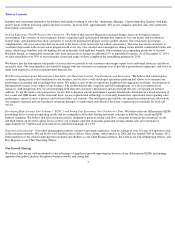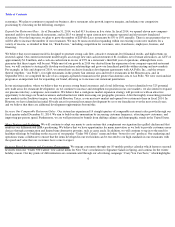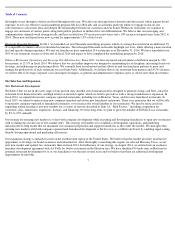El Pollo Loco 2015 Annual Report Download - page 17
Download and view the complete annual report
Please find page 17 of the 2015 El Pollo Loco annual report below. You can navigate through the pages in the report by either clicking on the pages listed below, or by using the keyword search tool below to find specific information within the annual report.
Table of Contents
other licenses and registrations, or exemptions thereto, would adversely affect the operations of restaurants. Although we have not experienced,
and do not anticipate, any significant problems in obtaining required licenses, permits, or approvals, any difficulties, delays, or failures in
obtaining such licenses, permits, registrations, exemptions, or approvals could delay or prevent the opening of, or adversely impact the viability
of, a restaurant in a particular area.
The development and construction of additional restaurants will be subject to compliance with applicable zoning, land use and environmental
regulations. We believe that federal and state environmental regulations have not had a material effect on operations, but more stringent and
varied requirements of local government bodies with respect to zoning, land use, and environmental factors could delay construction and
increase development costs for new restaurants.
We are also subject to the Fair Labor Standards Act, the Immigration Reform and Control Act of 1986, and various federal and state laws
governing such matters as minimum wages, overtime, unemployment tax rates, workers’
compensation rates, citizenship requirements, and other
working requirements and conditions. A significant portion of our hourly staff is paid at rates consistent with the applicable federal or state
minimum wage and, accordingly, increases in the applicable minimum wage will increase our labor costs. We are also subject to the Americans
With Disabilities Act, which prohibits discrimination on the basis of disability in public accommodations and employment, and which may
require us to design or modify our restaurants to make reasonable accommodations for disabled individuals.
For a discussion of the various regulatory and compliance risks that we face, see Item 1A, “Risk Factors.”
Management Information Systems
All of our company-operated and franchised restaurants use computerized point-of-sale and back-office systems, which we believe can scale to
support our long-term growth plans. Our point-of-sale system provides a touch-screen interface and integrated, high-speed credit card and gift
card processing. Our point-of-sale system is used to collect daily transaction data, which provides daily sales and product mix information that
we actively analyze.
Our in-restaurant back-office computer system is designed to assist in the management of our restaurants and to provide labor and food cost
management tools. The system also provides corporate headquarters and restaurant operations management quick access to detailed business
data, and reduces the time spent by restaurant managers on administrative needs. The system further provides sales, bank deposit, and variance
data to our accounting department on a daily basis. For company-operated restaurants, we use this data to generate weekly consolidated reports
regarding sales and other key measures, as well as preliminary weekly profit and loss statements for each location, with final reports following
the end of each period.
Employees
As of December 31, 2014, we had approximately 4,687 employees, of whom approximately 4,545 were hourly restaurant employees comprised
of 3,882 crewmembers, 192 general managers, 192 assistant managers, 241 shift leaders, and 38 employees in limited-time roles as acting
managers or as managers in training. The remaining 142 employees were corporate and office personnel. None of our employees are part of a
collective bargaining agreement, and we believe that our relationships with our employees are satisfactory.
Seasonality
Seasonal factors and the timing of holidays cause our revenue to fluctuate from quarter to quarter. Our revenue per restaurant is typically lower
in the first and fourth quarters due to reduced January and December traffic and higher in the second and third quarters. As a result of
seasonality, our quarterly and annual results of operations and key performance indicators such as company restaurant revenue and comparable
restaurant sales may fluctuate.
13
























